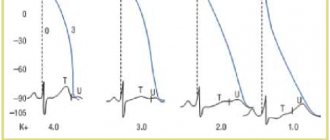Indications for the study
A blood test for magnesium can be prescribed at certain intervals to monitor the condition of patients whose diseases are accompanied by potassium or calcium deficiency. The test is also prescribed if the following symptoms are present:
- impaired clarity of consciousness;
- muscle weakness;
- heart rhythm disturbance;
- cramps or muscle twitching.
Also, the amount of this macroelement must be monitored in patients with alcoholism, malabsorption syndrome, diarrhea, and nutritional deficiency. For patients with diabetes and chronic kidney problems, this test is prescribed regularly at certain intervals. Its results are used to evaluate kidney function.
Products containing magnesium
The natural question is, what foods contain magnesium? Most of the food we eat daily contains this element.
Table of magnesium content in products, per 100 g:
| the product's name | amount, in mg |
| wheat bran | 590 |
| pumpkin seeds | 520 |
| cocoa powder | 480 |
| sunflower seeds | 370 |
| coffee | 320 |
| chocolate | 300 |
| black caviar | 300 |
| cashew nuts | 270 |
| pine nuts | 270 |
| watermelon | 230 |
| peanut | 210 |
| seaweed | 170 |
| oat flakes | 160 |
| walnuts | 160 |
| rice | 140 |
| pearl barley | 130 |
| dried apricots | 110 |
| buckwheat | 100 |
In addition, less than 100 mg is found in spinach, raisins, dates, corn, bananas, beets, cottage cheese, potatoes and other products.
General information
Like other macro- and microelements necessary for the body, magnesium comes with food and is absorbed into the gastrointestinal tract. There is a small amount of it in the blood (about 1%), the main part is found in various cells and tissues. Normally, the amount of a macronutrient is maintained at a stable level by regulating its absorption and excretion in the urine. An excess of this substance can occur with an overdose of drugs containing magnesium compounds, as well as in the case of kidney dysfunction. A deficiency of a macronutrient may not manifest itself in any way for quite a long time. If its deficiency is significant or is not replenished for a long time, symptoms such as decreased appetite or its complete loss, nausea, weakness, muscle spasms, and confusion appear. When there is an excess of a macronutrient, similar symptoms appear. Heart rhythm disturbances may also be added to them.
When should you take a Magnesium (blood) test?
- Suspicion of the development of magnesium deficiency;
- Suspicion of the development of hypermagnesemia (increased magnesium in the blood);
- Comprehensive examination of persons with malabsorption of nutrients and persons suffering from alcoholism;
- Treatment with drugs that affect the level of magnesium in the body;
- Presence of diabetes mellitus, kidney disease;
- To assess renal function (along with the determination of blood urea and creatinine);
- Determining the cause of low levels of calcium, potassium, phosphorus in the blood.
Interpretation of results
The test uses venous blood. It is taken on an empty stomach after a 12-hour fasting break. Interpretation of the results is carried out taking into account the patient’s age, clinical picture, data from other laboratory and instrumental studies.
Flaw
macronutrient may indicate diabetes mellitus, Crohn's disease, hypoparathyroidism, diarrhea. It is also often observed in toxicosis of pregnant women. Low rates can also be explained by lack of nutrition (for example, in patients with alcoholism or in the elderly), long-term use of a number of medications. During pregnancy (second and third trimester), low levels are usually caused by an increased need for this macronutrient.
Oversupply
magnesium is observed in patients with renal failure, hypothyroidism, hypoparathyroidism, Addison's disease, and dehydration. Excessive accumulation of macronutrients can also be caused by medications (eg, certain antibiotics, aspirin).
In most cases, this test is not used as an independent study, but is prescribed in conjunction with tests for other electrolytes. If its results are within normal limits, this does not make it possible to completely exclude macronutrient deficiency. Due to natural compensation mechanisms, its level in the blood can be maintained within normal limits for a long time. In this case, macronutrient reserves are released from body tissues. To make an accurate diagnosis, additional examination is required in such cases.
Modern approaches to replenishing magnesium deficiency in women. Mezhevitinova E.A.
Oksana Mikhailovna Drapkina , professor, doctor of medical sciences:
– We are moving from narcology to the field of gynecology, and Professor Elena Anatolyevna Mezhevitinova will now talk about modern approaches to replenishing magnesium deficiency in women.
Elena Anatolyevna Mezhevitinova , professor, doctor of medical sciences:
– Good afternoon, dear colleagues. Magnesium deficiency is an acute problem, because magnesium comes to us only through food. Human food includes a large number of different components. These are macronutrients, which include proteins, carbohydrates, and fats. These are micronutrients, which include vitamins, minerals or elements that are found in the body in excess of 100 milligrams. Microelements are those trace elements that are found in less than 100 milligrams in the body. Therefore, if I asked a question: which of these micro and macronutrients listed is the most important? – it is not thorough and it is clear that a lack of any of this group of nutrients can lead to catastrophic conditions and diseases. In fact, magnesium is a macronutrient. Its total content in the body is only 0.027%, which is 21-28 grams in an adult. Magnesium is not synthesized in the body. It comes into our body only with food. And more than half of magnesium ions, more than 53%, are contained within the cell - in dentin, tooth enamel, bones, and in tissues with the most pronounced metabolic activity (brain, heart, muscles, kidneys, liver, placenta). In the extracellular environment it is only 1%, and in the blood plasma, which we are used to determining the level of magnesium, it is only 0.3%. Physiologically, only free magnesium is considered active. Magnesium is the central molecule of chlorophyll, so greens contain the most magnesium. But what kind of green? Which grows in a garden bed, on which the sun is shining, and which we picked and immediately ate. If you put them in the refrigerator and keep them there for 2-3 days, there is no magnesium in this herbal preparation. And if I asked, when did magnesium appear on Earth? This is 3.5 billion years ago. This is the third day of the creation of the world. And God said: “Yes, the earth will bring forth grass, grass yielding seed, a fruitful tree bearing fruit according to its kind, in which is its seed on the earth” - and it was so. And the earth brought forth grass, grass yielding seed according to its kind, and a tree yielding fruit, in which is its seed according to its kind. And God saw that it was good. There was evening and there was morning - the third day. Thus, magnesium appeared on Earth. The fact is that the nutrition of modern man is characterized by deformation of the mineral composition of the diet with a predominance of NaCl, with a deficiency of salts K, Mg, Ca, iodine and zinc. Indeed, look, few of the population eat unsalted food, for example. What is salty food? This is NaCl. Therefore, the normal level of magnesium in the human body is recognized as a fundamental constant that controls human health. And according to the International Classification of Diseases (ICD-10) there is a diagnosis: “Magnesium deficiency” - which is coded E61.2. Magnesium and calcium are ions responsible for stabilizing the human genome. Therefore, their normal content prevents the start of many negative immunological programs, including oncological ones.
There are studies that prove that when magnesium is deficient, lymphoma, cancer of the kidneys, bladder, colon, cervix, and so on develop more often. The daily requirement for magnesium for healthy women is 300-350 milligrams, with a deficiency - 500-600 milligrams, and for men - up to 800 milligrams. Studies have been conducted to examine the level of magnesium in women, or rather in general in the population of various countries. These are America, Canada, Europe, Finland, Mexico, Russia, and as you can see in almost all countries of the world, we have a magnesium-deficient population. And it’s clear why? Look at our children, what do they eat? Do they prefer, for example, to go to some theater or museum on Sunday? Or go to McDonalds and get some fast food and wash down this fast food with Coca-Cola, which very quickly removes magnesium from the body. Our teenagers very often drink alcohol-containing drinks, and this also removes magnesium from the body very quickly. In fact, obesity is now considered a pandemic. And the number of women who are obese, unfortunately, is growing and growing all the time. And, naturally, our women - they want to be beautiful, they begin to use various special diets to lose weight. But special diets also pose a risk of magnesium deficiency. Look, our children love discos, they live the nightlife, sit at the computer, and sleep during the day. And this nightlife also predisposes to magnesium deficiency. Loud sound, flashing sounds are also a magnesium deficiency. And I can also tell you, my dear colleagues, that we, doctors who are on duty in clinics, do not sleep at night, we are also at risk for magnesium deficiency, since inversion of sleep and wakefulness occurs.
It is extremely difficult to diagnose magnesium deficiency. The fact is that normally it is 0.5 and 1 mmol/l, but given that magnesium is inside the cell, we see only 0.3% of it in the plasma and therefore it is extremely difficult to diagnose magnesium deficiency. If the magnesium deficiency is 0.7 or less, then we can diagnose a non-severe magnesium deficiency. If 0.5 or less, this is a severe magnesium deficiency. But even within the normative values, we can also suspect magnesium deficiency in our women. Fluctuations in the level of magnesium in the blood plasma do not reflect the saturation of this element. Serum magnesium levels can remain within normal limits even when total body magnesium levels are reduced by 80%. A study was conducted where it was very clearly shown that all women whose blood plasma magnesium level is 0.7 mmol/l are 90% of magnesium-deficient women when this level in red blood cells was determined. If 0.75% means 50% of women are magnesium deficient. If 0.8 is 10%. And even at 0.9 - this is, in general, the absolute norm - 1% of women will be magnesium deficient. In general, in fact, a woman is exposed to magnesium deficiency throughout her life: from birth to old age. Moreover, magnesium deficiency intensifies, increases and becomes total by the age of 70. Therefore, prevention of magnesium deficiency is a very important phenomenon. And often we simply do not make this diagnosis, because obvious symptoms of magnesium deficiency are most often absent, and we can suspect magnesium deficiency if we talk very carefully and confidentially with our patient. After all, its deficiency can manifest itself with some typical pain, gastrointestinal disorders, increased fatigue, the appearance of muscle cramps in the back of the head, back, face, calf muscles, and soles of the feet. By the way, for the first time magnesium was used for therapeutic purposes specifically in patients who suffered from cramps of the calf muscles. This may be paresthesia of the limbs, it may be dizziness, nystagmus, a feeling of suffocation. And, by the way, there are patients who come and say: “You know, there’s a lump in my throat, I can’t breathe,” and we don’t find anything with them. This is a magnesium deficiency and magnesium can help in this regard. Increased blood pressure, cardialgia, insomnia, manifestation of some fears, aggression, irritability, depressive states are also symptoms of magnesium deficiency. Well, if there is a chronic magnesium deficiency, which we did not pay attention to in time, then, of course, in this patient this can lead to magnesium deficiency diseases. And there are quite a lot of such diseases. This is delayed sexual development; this is the formation in adolescence of a predisposition to alcohol, drugs and smoking; to disruption of the development of connective tissue and the occurrence of undifferentiated dysplasia. Look at the number of patients who come to see us and notice that they have mitral valve prolapse. The girls who come are very young, and we see stretch marks in the abdominal area and in the mammary glands. This is also a magnesium deficiency. What about the size of the perineum during childbirth? What about prolapse of the vaginal walls? It is also undifferentiated connective tissue dysplasia, which is, in principle, a magnesium deficiency condition. It can lead to menstrual irregularities, vulvar pathology and delayed healing of the cervix after treatment of pathological processes. Such a study was also conducted, where when preventive magnesium was prescribed, cervical healing was 2.5 times faster than without its prescription. Well, and, of course, miscarriage.
Genetically determined magnesium deficiency can serve as one of the causes of allergic reactions, and in our country, look at the level of allergization in the population. The body's sensitivity to bacterial and viral infections increases with magnesium deficiency, which leads to more pronounced bacterial and toxic shock. Magnesium regulates phagocytosis. Magnesium improves the maturation of T-lymphocytes, the synthesis of immunoglobulin, prevents sensitization, and reduces the risk of developing inflammatory diseases of the pelvic organs.
Look at the women who come to us and what antibiotics, how often we prescribe to our women for various sexually transmitted infections or very often for vulvovaginitis, chronic cervicitis. But we must understand that taking aminoglycosides, for example - and we are sometimes afraid even of Gentamicin, Neomycin, Spiromycin, Cyclosporin - can lead to a very rapid loss of magnesium in the urine, reduces the level of magnesium in the ciliated epithelial cells cochlea of the ear. And all this leads to tinnitus, dizziness, excess insulin secretion, hardening of the arteries and even hearing loss. Very often, especially for various sexually transmitted infections, tetracycline antibiotics and fluoroquinolones are prescribed, which leads to a decrease in the absorption of magnesium from food in the intestine. Sparingly soluble compounds are formed, and the effectiveness of tetracycline antibiotics decreases, and magnesium simply does not enter the blood and therefore magnesium deficiency develops in the woman’s body. How many women in our country use combined estrogen-gestagen drugs? Well, hormone replacement therapy is now used a little less by women; it is used only to reduce various vegetative disorders: phytoestrogens. But estrogen-containing drugs fix magnesium in bones, hair follicles, nails, tendons, ligaments, and a relative deficiency of magnesium in the blood and tissues occurs naturally. Hypomagnesemia, a consequence of magnesium redistribution, leads to vitamin B6 deficiency. It must be said that magnesium deficiency is almost always accompanied by a deficiency of vitamin B6. And, in fact, such a systematic review was conducted where 12 placebo-controlled studies were analyzed. And this meta-analysis showed that the use of oral contraceptives leads to a sharp drop in the concentration of vitamin B6 after 1-3 months.
Back in 1983, Professor Beresh said: “Magnesium plays a starting role in the rehabilitation of osteogenesis, in the implementation of the beginning of the elemental cascade with calcium.” And many studies have clearly shown that magnesium deficiency contributes to changes in the activity of osteoblasts, osteocytes, and osteoclasts; reduces the sensitivity of bone tissue to parathyroid hormone; reduces calcium absorption due to the formation of inactive vitamin D metabolites. And, of course, magnesium deficiency contributes to the aging of a woman’s bones. Magnesium deficiency leads to increased fatigue, decreased attention, concentration, increased sensitivity to stress, and the development of chronic fatigue syndrome, which is now, in general, very relevant and a lot of researchers come and study this problem. Suffice it to say that just 10 minutes of stress burns up the daily requirement of magnesium. And, as a result, magnesium is removed from the cells, magnesium binds in the blood, a deficiency occurs, and chronic deficiency leads to a magnesium deficiency state. A meta-analysis was conducted and Cochran's collaborators found 12 randomized clinical trials on the therapeutic aspect of Magne B6 for dysmenorrhea. And it has been clearly shown that magnesium reduces the production of Pg F2a, which means that the uterine muscle does not contract, does not compress blood vessels, hypoxia does not develop, various biological substances are not released, nerve endings are not irritated, and the woman feels relief or disappearance of pain during dysmenorrhea.
What about premenstrual syndrome syndromes? Yes, almost 90% of women have certain symptoms of premenstrual syndrome and this has also been clearly proven. By the way, more than one study was conducted and various vitamins were studied, magnesium, combined estrogen-progestogen drugs, contraceptives were studied, and it was absolutely clearly shown that the contraceptives that were sold in our pharmacy chain until 2003 did not prove effective against premenstrual syndrome. But Magne B6 drugs have confirmed their effectiveness and these meta-analyses have proven the effectiveness of this drug and the relevance of prescribing it for premenstrual syndrome. A study was conducted where they looked at magnesium in red blood cells, and in women with PMS, magnesium in the second phase of the cycle was much lower, statistically lower, than in healthy women who did not experience PMS. There were a lot of such studies. And these studies began to be carried out in 1990, and a huge number of schemes were used. They were also prescribed in the second phase of the cycle, during the first two months, continuously. And it was clearly shown that during the first two months of treatment there was a significant reduction in the total index of symptoms, especially pain and hydration symptoms. Magnesium concentration increased significantly in leukocytes. In 2000, a meta-analysis was also performed, describing a randomized, double-blind, placebo-controlled crossover study in which magnesium and B6-containing drugs were prescribed for 4 menstrual cycles, and a significant reduction in anxiety and irresistible cravings was also noted. eating, and, by the way, the same study showed a decrease in cravings for drinking alcohol.
Our center also conducted studies (2005-2006), where 120 women aged 18 to 50 years participated and were assigned to two groups. One group was prescribed only in the second phase of the cycle, the other for 6 months. And they also showed a decrease in pain, hydration, nervousness, and sleep disturbances. And we did not find any statistical difference between these two groups. We currently have drugs that can be used. This is Magne B6, which contains: magnesium lactate 470 milligrams and pyridoxine 5 milligrams, which is 48 milligrams of elemental magnesium. Therefore, these drugs are prescribed 2 tablets 3 times a day, that is, a total of 288 milligrams. Moreover, if there is a deficiency, keep in mind that this does not cover the deficiency, and we need 300-350 in healthy women. There is also a tablet form, recently launched on the market, “Magne B6 Forte”, which includes: magnesium citrate 618 milligrams and pyridoxine 10 milligrams, that is, vitamin B. It is used one tablet 3 times a day, without breaking the tablet, entirely, during meal time with a glass of water. Well, and, of course, there is a magnesium solution “Magne B6”, which includes: lactate 186 milligrams, pidolate 936 milligrams and also vitamin B 10 milligrams, that is, 100 milligrams of elemental magnesium. Use 1 ampoule, this is a drinking solution, 2-3 times a day. By the way, it was the “Magne B6” solution that was created for athletes, which replenishes energy costs, relaxes overworked muscles and, in general, has a fairly good effect on the body and the body’s resistance in athletes. We conducted a study this year, where there were 69 women using Magne B6 Forte, 1 tablet 3 times, and we absolutely got statistically significant results for joint pain, for cramps in the calf muscles, for cystalgia, for lower pain abdomen, and these statistical results were very pronounced (p
Therefore, in conclusion, let me say that magnesium, a nutrient that is not synthesized in the body, is found in small quantities. The risk of developing a magnesium deficiency state is very high and accompanies a woman throughout her life, increasing with age, reaching total after 70 years. It is aggravated by the use of antibiotics, estrogen-containing drugs, leading to the development of menstrual irregularities, dysmenorrhea, PMS, depressive states, asthenic, convulsive syndrome, chronic fatigue syndrome and metabolic syndrome. The use of magnesium preparations is effective, practically does not cause adverse reactions, helps prevent the occurrence of various diseases and improves the quality of women, our patients. A woman’s body is a complex “instrument” that needs to be learned to play. Thank you for your attention.
About the reasons for low magnesium
To properly begin to treat magnesium deficiency, it is necessary to determine the cause. As a rule, this condition mainly occurs in the human body when:
- poor nutrition;
- passion for alcoholic beverages;
- constant stress;
- abuse of animal proteins;
- in athletes and in children’s bodies with rapid muscle growth;
- when taking medications containing hormones;
- when carrying a baby and breastfeeding it;
- during strenuous physical activity or a sedentary lifestyle;
- disturbances of metabolic processes in the body, characteristic of obesity, diabetes, dysbacteriosis.
Children's bodies are especially sensitive to the lack of this element, which is a consequence of poor nutrition.
If there is a shortage of a microelement, the blood will “pull” it from all organs, which will greatly affect your health. Food should not consist only of products made from flour; it is imperative to include fresh vegetables and fruits in the diet.
Symptoms indicating magnesium deficiency
Feeling lethargic is an indicator of magnesium deficiency.
It is not difficult to understand that the body does not have the required amount of magnesium. Indeed, if there is a lack of this microelement, a person will experience general malaise. The first indicators of magnesium deficiency:
- Feeling lethargic
- It's hard to wake up in the morning
- Irritation
- Attacks of fear
- Depressive state
- Headache
- Dizziness
People complain, saying that it seems like you haven’t worked much, but you don’t have the strength, you get tired quickly. This is also an indicator of magnesium deficiency. Irritability, depression and attacks of fear are caused by the fact that the nervous system reacts acutely to the lack of this microelement.
It would seem that the body lacks only one microelement, but the person already suffers from nightmares caused by a depressive mood, and also often experiences a nervous tic. As a result, the body is exhausted and the person walks around “broken” all day.
In addition, due to magnesium deficiency, not only headaches occur, but also the structure of the hair is often disrupted, the ends of which become brittle. And a lack of microelement does not bring benefits to teeth.
Magnesium deficiency can lead to the development of dental caries.
Symptoms may also include muscle cramps. They appear in the feet, hands and calf muscles. Magnesium deficiency does not bypass the cardiovascular system. A person exhibits tachycardia and arrhythmia. Changes in blood pressure are possible.
Despite such a large number of consequences due to a lack of magnesium, this is not a complete list of ailments. A person may complain of problems in the digestive tract and abdominal pain. And in addition, the body will become more sensitive to changing weather conditions. This will manifest itself in aching joints or muscle pain.
4.Treatment
Obviously, the first priority in the treatment of magnesium deficiency is a radical reduction (and, if possible, complete elimination) of all controllable causes and risk factors associated with diet and lifestyle. Further, today many magnesium-containing preparations and supplements have been developed and are successfully used that can compensate for the deficiency of this element in the body. Great importance is attached to calcium-magnesium mineral waters.
Mention of therapeutic success is by no means empty words. Serious, properly organized medical and statistical studies have been carried out, showing: magnesium is indeed an antiplatelet agent and significantly reduces mortality, in particular from post-infarction ventricular arrhythmia, thrombosis and other complications, not to mention the normalization of somatic and neuropsychic status.
However, it should be absolutely clear that any treatment of this kind can only be carried out as prescribed by a doctor, after a thorough clinical and biochemical examination.
1.General information
Today, a lot is often written about the importance of vitamins and microelements for health, longevity and effective functioning of the body. In this regard, humanity has gone through various, including not entirely adequate, stages of understanding and attitude towards the problem (remember, at least, the hysterical “vitamin mania” of the 1960-70s in the USA, largely provoked by drug manufacturers and beneficial, first of all, to them) . However, the problem itself does not disappear; it remains acute and relevant in almost all regions of the globe. In recent decades, much attention has been paid, for example, to iodine deficiency conditions and diseases that were previously explained by completely different reasons.
Magnesium is one of the most important, “framework” chemical elements that ensure the normal functioning of the human body. One-fifth of the total volume of magnesium is contained in the tissues of the central nervous system, the same amount is found in the liver, kidneys and muscles, including the myocardium. Even these simple data indicate the importance of normal (no more or less than the required level) magnesium concentration for the functioning of vital organs.
The main part, that is, about 60% of the total magnesium reserve, is found in bone tissue, including dentin and tooth enamel. It has been established that magnesium is involved in more than 300 key biochemical reactions.
Research conducted in recent years, the results of which are published in the world's specialized periodicals, clearly proves: the vast majority of people in developed countries are at risk for magnesium deficiency, and the role of this deficiency in the pathogenesis of many diseases is, in all likelihood, underestimated.
A must read! Help with treatment and hospitalization!







